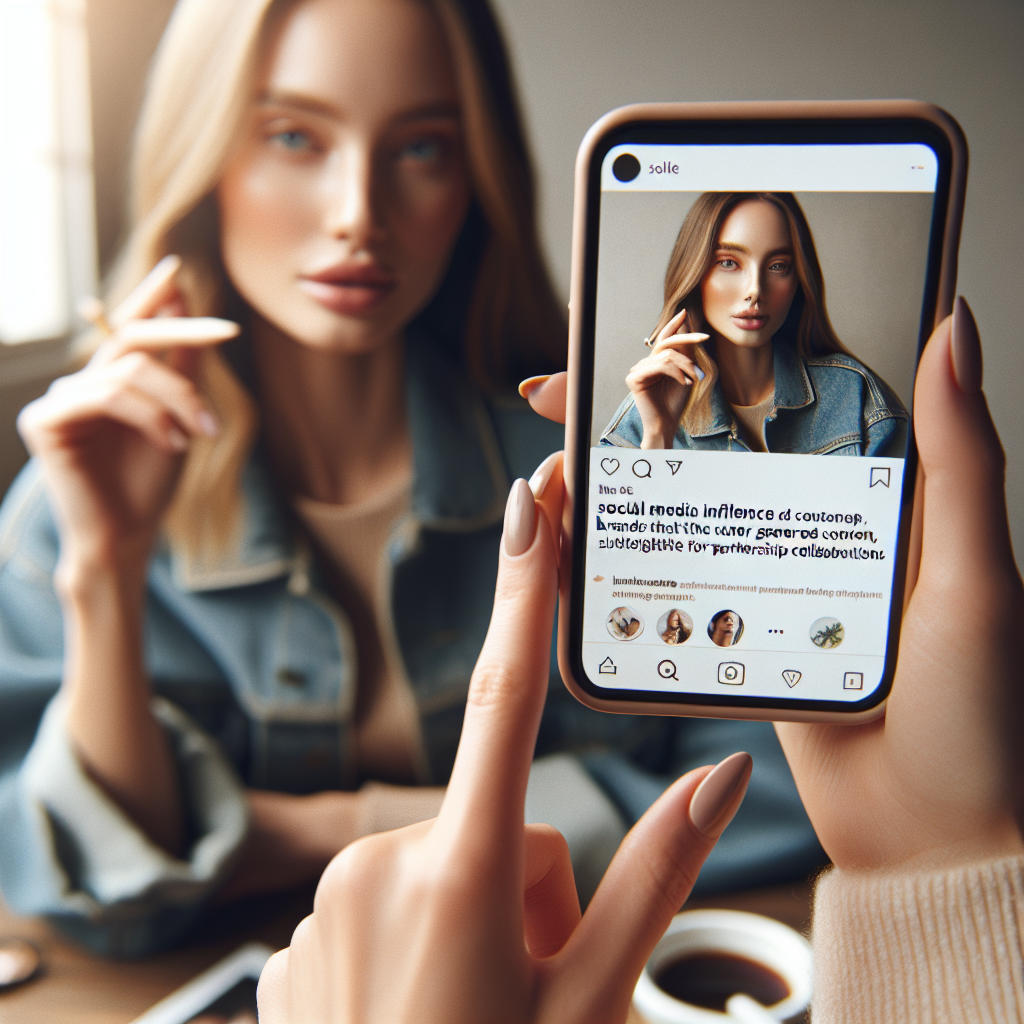Introduction To Finding Makeup Brands
Are you working as a user-generated content (UGC) creator and looking for ways to connect with brands for collaborations?
In such a booming digital era, finding and working with brands can seem complex and overwhelming.
But don’t fret!
In this article, we’ll guide you through simple, effective ways to discover brands that align with your niche, and how to reach out and maintain a beneficial relationship with them.
The goal here is to equip you with proven suggestions and informative insights that can help streamline your path to fruitful brand collaborations.
So, are you ready to step up your game as a UGC creator? Let’s jump in!
Table of Contents
Finding Brands to Work with as a UGC Creator
Leverage Social Media Platforms
Social media is a treasure trove for finding brands. Use platforms like Instagram, Twitter, and LinkedIn to discover brands that align with your niche. Search relevant hashtags and follow industry leaders.
- Instagram: Look for branded hashtags and explore companies that engage with similar content.
- Twitter: Follow brand accounts and join industry-related Twitter chats.
- LinkedIn: Connect with brand managers and marketing professionals.
Utilize Online Marketplaces
There are several online marketplaces designed to connect influencers and content creators with brands. Some popular options include:
| Marketplace | Description |
|---|---|
| FameBit | A platform owned by YouTube that allows you to connect with brands for sponsored video content. |
| Influencity | Offers a database of over 70 million influencers and brands for various collaborations. |
| Fohr | Matches influencers with brands based on data-driven analytics. |
Attend Industry Events and Webinars
Participating in industry events, webinars, and virtual networking sessions can be a gateway to meeting brand representatives.
- Trade Shows: These offer direct access to brand executives and marketers.
- Webinars: Focus on webinars hosted by industry leaders to understand their brand strategies.
- Networking Events: Attend these to build relationships that could lead to collaborations.
Engage with Brands Directly
Proactively reach out to brands you admire. Craft a compelling pitch, showcasing how your content can add value to their marketing efforts.
- Email Outreach: Send personalized emails to brand representatives.
- Social Media DMs: Direct messaging can sometimes yield quicker responses.
- Engage with Content: Regularly like, comment, and share brand posts to get noticed.
Build an Outstanding Portfolio
Presenting a well-structured portfolio can make a significant impact. Include case studies, content samples, and performance analytics to demonstrate your capability.
- Case Studies: Showcase previous successful campaigns.
- Content Samples: Display a variety of your best work.
- Analytics: Provide data to highlight your content’s reach and engagement.
Join Creator Communities
Being part of influencer and creator communities can provide you with insights and opportunities. Platforms like Reddit, Facebook Groups, and specialized forums are great places to start.
- Reddit: Find and join subreddits related to influencer marketing.
- Facebook Groups: Participate in groups for content creators where brands often post collaboration opportunities.
- Forums: Engage in discussions on specialized forums like Warrior Forum.
Use Brand Partnership Tools
Leverage tools designed to facilitate brand collaborations. These tools often have extensive databases and matchmaking features.
- CreatorIQ: This tool offers in-depth analytics to help you find brands that fit your profile.
- Upfluence: A comprehensive influencer marketing platform that connects you with brands based on your audience and content performance.
Identifying Makeup Brands to Collaborate with as a UGC Creator
Finding Beauty Brands on Social Media
While perusing social media remains important, understanding certain platforms where beauty brands are notably active is key. Makeup brands frequently use platforms like Instagram and YouTube to showcase their products visually.
- Instagram: Besides looking for branded hashtags, monitor sponsored posts and tagged photos to discern which brands collaborate with UGC creators.
- YouTube: Research makeup tutorials and product reviews to find brands sponsoring UGC content. Follow popular beauty influencers and take note of who sponsors them.
Discovering Beauty Brands on Online Marketplaces
Certain online marketplaces are especially popular with beauty brands seeking collaborations.
| Marketplace | Description |
|---|---|
| Octoly | Well-known among beauty influencers, Octoly facilitates collaborations with beauty brands, offering free products in exchange for reviews and posts. |
| Influenster | Influenster connects UGC creators with brands for product reviews, often in the beauty and skincare industry. |
Opportunities at Beauty Industry Events and Webinars
Beauty industry events provide excellent chances to network and build relationships with relevant brands.
- Beauty Trade Shows: Trade shows like Beautycon offer numerous opportunities to meet beauty brand reps.
- Brand-Specific Events: Brands like Sephora and Ulta host events tailored to influencers and UGC creators.
Engaging with Beauty Brands Directly
When reaching out to beauty brands, ensure your pitch is tailored to their specific products and marketing needs. Show them you understand their products and audience.
- Product-Specific Pitches: Demonstrating your knowledge about a brand’s product line will make your pitch more compelling.
- Audience Relevance: Highlight your audience’s interest in beauty products to underscore the potential for a successful collaboration.
Creating an Effective Portfolio for Beauty Brands
Your portfolio should showcase your proficiency in creating compelling content for beauty products.
- Makeup Tutorials: Show off your skills with makeup through tutorial videos or photos.
- Product Reviews: Include examples of past product reviews to demonstrate your ability to promote beauty brands.
Participating in Beauty Focused Creator Communities
Joining beauty-centric communities will give you deeper insights into the beauty industry and allow for networking with brands that cater to your niche.
- Reddit: Check out makeup and beauty dedicated subreddits like r/MakeupAddiction and r/SkincareAddiction.
- Beauty Forums: Websites such as Makeup Talk offer dedicated platforms for beauty influencers and brands to connect.
Using Brand Partnership Tools for Beauty Collaborations
Leverage tools specifically geared towards beauty influencers to streamline finding and connecting with the right brands.
- Tribe: This app has a section specifically for beauty influencers, making it easy to find beauty brands looking for partnerships.
- AspireIQ: Known for its huge database of beauty brands, AspireIQ simplifies the process of finding potential partners.
Do Brands Send You Products for UGC?
Getting Started with Product Requests
If you’re new to User Generated Content (UGC), you might wonder, “Do brands send you products for free?” The answer is yes, brands often send products to creators for UGC. However, it’s not always straightforward. Here’s what you need to know:
- Initial Outreach: Often, you’ll need to initiate contact with brands. Show genuine interest in their products and explain how your content aligns with their brand values.
- Micro-Influencers: Brands frequently work with micro-influencers (those with 1,000 to 100,000 followers) as they tend to have more engaged audiences. Even if your follower count is on the lower end, your engagement rate can make a difference.
Building Long-Term Relationships
Brands don’t just want a one-time post; they often seek long-term relationships. Showing consistency in your content and maintaining good communication can pave the way for ongoing collaborations.
- Follow-Up Post: After your initial post, create follow-up content to show ongoing support for the brand.
- Content Insights: Share analytics with the brand to demonstrate the impact of your posts.
Understanding Brand Expectations
When brands send you products, they usually have specific expectations about the type of content you’ll create.
| Type of Content | Example |
|---|---|
| Product Reviews | Detailed reviews showcasing product benefits and usability. |
| Tutorials | Step-by-step guides to using the product effectively. |
| Unboxing Videos | First impressions and detailed looks at the product’s packaging and initial use. |
Compensation Beyond Products
While receiving free products can be exciting, it’s important to consider other forms of compensation. Some brands offer payment in addition to products, particularly once you have proven your value.
- Paid Collaborations: Negotiate your rates based on the type and extent of content required.
- Affiliate Programs: Some collaborations come with affiliate links, allowing you to earn a commission on sales generated through your content.
Legal Considerations
When brands send you products, there are often legal aspects to consider, particularly regarding disclosure and rights to your content.
- Disclosures: According to the Federal Trade Commission (FTC), you must disclose any free products or paid partnerships to your audience.
- Usage Rights: Clarify with the brand how they can use your content. Some brands may want to repurpose your photos or videos for their own marketing efforts.
Tracking and Reporting
Keeping track of the content you create and the results it generates can help you build a robust portfolio, which can be instrumental in securing future collaborations.
- Content Calendar: Maintain a schedule to ensure timely posting and help manage multiple collaborations.
- Performance Metrics: Use tools like Google Analytics and native platform insights to track engagement, reach, and conversion rates.
By understanding these key points, you can effectively manage the process of receiving brand products for UGC and build meaningful relationships that benefit both you and the brands you work with.
Enhancing Your Outreach Strategy as a UGC Creator
Creating a Professional Media Kit
A media kit is your best marketing tool when reaching out to brands. It provides an overview of your brand, content, and audience.
- Introduction: Begin with a brief introduction about yourself, your niche, and your unique selling points.
- Audience Demographics: Include details about your followers, such as age, gender, location, and interests.
- Metrics: Display your reach, engagement rates, and any significant past campaign performance metrics.
- Services Offered: Clearly outline the types of content and services you can provide to the brand.
Personalizing Your Outreach
Personalization can significantly improve your chances of getting a positive response from brands.
- Address by Name: Find out the name of the brand representative and address them personally in your email or message.
- Customized Pitches: Tailor your pitch to speak specifically to the brand’s values, past campaigns, and current initiatives.
- Mention Shared Interests: Point out any shared interests or mutual connections to build rapport.
Highlighting Previous Collaborations
Showcase your past successful collaborations to build credibility.
- Portfolio Section: Create a section in your website or media kit dedicated to case studies of past brand collaborations.
- Testimonials: Include testimonials from previous brand partners to vouch for your reliability and effectiveness.
Leveraging Data and Analytics
Brands are increasingly data-driven, so showing you can provide tangible results will make you a more appealing partner.
- Track Performance: Use tools like Google Analytics, Facebook Insights, and Instagram Analytics to track the performance of your posts.
- Report Success: Include data that shows your content’s success in driving engagement or sales for previous brand partners.
Building Authority in Your Niche
Becoming a recognized authority in your niche can help attract brand collaborations.
- Consistent Content: Publish content regularly to showcase your expertise and build a loyal audience.
- Guest Posting: Write guest posts for well-known blogs in your niche to gain visibility and authority.
- Public Speaking: Participate in webinars, podcasts, or industry panels to further establish yourself as a thought leader.
Utilizing Email Marketing
Effective email marketing helps keep brands updated about your activities and builds long-term relationships.
- Newsletter: Start a newsletter to share updates, industry insights, and highlights of your work.
- Automated Follow-Ups: Use email marketing tools to send automated follow-up emails, ensuring you stay on top of your outreach efforts.
Setting Clear Expectations
When initiating contact or working with a brand, clarity on expectations will pave the way for a smooth collaboration.
- Deliverables: Clearly define what content you will create and the timelines for delivery.
- Performance Goals: Discuss any performance metrics or objectives to meet, such as engagement rates or sales targets.
- Compensation: Negotiate and agree on compensations, whether it’s monetary, free products, or other benefits.
By focusing on these elements, you can significantly enhance your outreach strategy and build stronger, more successful relationships with brands as a UGC creator.
Frequently Asked Questions – FAQs
How can I find suitable brands to collaborate with as a UGC creator?
You can utilize social media platforms, online marketplaces, industry events, direct engagement, portfolio building, creator communities, and brand partnership tools to identify and connect with potential brands.
Which social media platforms are recommended for finding brands to collaborate with in the makeup industry?
Instagram and YouTube are notably interacted with by makeup brands. Monitoring sponsored posts, tagged photos, makeup tutorials, and product reviews on these platforms can reveal potential collaboration opportunities.
Are there any special tips for engaging directly with beauty brands?
When reaching out to beauty brands, ensure your pitch is tailored to their specific products and marketing needs. Show them you understand their products and audience.
What’s the usual expectation when brands send products for User-Generated Content (UGC)?
Brands usually anticipate product reviews, tutorials, or unboxing videos as types of content when they send products for UGC. Further, brands often seek long-term partnerships and expect a disclosure of the partnership to audiences as well as an agreement on usage rights.
Any tips on enhancing my outreach strategy as a UGC creator?
Creating a professional media kit, personalizing outreach, highlighting previous collaborations, leveraging data and analytics, building authority in your niche, utilizing email marketing, and setting clear expectations can greatly







